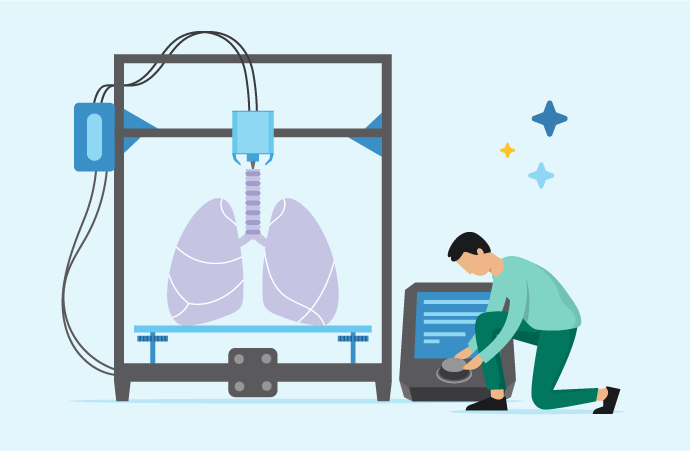In 2022, the first 3D-printed ear was successfully implanted on a twenty-year-old woman in Texas, made from her very own cells. While it may sound like science fiction, scientists predict that over the next 20 years or even sooner, bioprinting will become a reality in the field of regenerative medicine.
That’s because tissue including skin, muscles, bones, and blood vessels have already been 3D printed, it’s just that they are not yet approved for human use. When approval is eventually granted there’s no denying that bioprinting will be a gamechanger in the medical industry, enabling doctors to create human organs and tissue on-demand.
What is Bioprinting and How Does It Work?
Bioprinting is a technology that mixes biomaterials with cells to produce artificial organs or tissue that imitate the behaviour and structures of their natural counterparts. So how does it work exactly?
The first step is to create a digital file which acts as a 3D model for printing. Print cartridges are filled with bioink made from synthetic or natural biomaterials mixed with living cells from the patient. These are loaded into the 3D printer, which develops the structure layer-by-layer through an additive manufacturing process.
Not only does bioprinting have use in regenerative medicine, but it makes it easier to accurately study functions of the human body, aiding tissue engineering and pharmaceutical development. And research is already underway to use the technology on patients in clinical settings.
How Bioprinting Could Address the Organ Shortage Crisis
In the USA, over 100,000 men, women and children are currently on the transplant waiting list, with another person added every 10 minutes. Sadly, this means that 17 people die each day waiting for an organ transplant. A 3D printing process would significantly lower these wait times, by removing the need for a donor.
What’s more, because the printed organ is made from the patient’s own cells, the risk of organ rejection is drastically reduced. This also means the patient is less likely to need lifelong immunosuppressive medication which has other harmful side effects.
While it’s impossible to precisely estimate how close we are to making 3D printed organs a reality, the technologies are constantly improving. Scientists have been growing mini-organs in labs for years – including a kidney and a liver – and are working on making these full-size.
Revolutionizing Regenerative Medicine
Regenerative medicine is one of the most exciting areas in bioprinting research. 3D printing has an enormous potential to speed up the healing process of various tissues, including skin grafts, bone bandages, and patches on lungs.
Tissue engineering uses 3D printers to create personalised scaffolds on which cells are placed and structured into layers. The scaffold is embedded with collagen that promotes healing in the tissue and accelerates the growth of new cells into the scaffold, which then degrades into the body.
Scientists have already developed a mobile skin bioprinting system – in the future, this technology could be brought to the bedside of a burns patient, allowing skin to be 3D printed directly onto the wound, layer by layer. Bioprinting researchers have also tested 3D printing of skeletal muscle on rodents, which enabled them to regain 80% of lost muscular function.
What About the Ethical and Regulatory Landscape of Bioprinting?
Because bioprinting involves the use of living cells, it raises several ethical and legal issues regarding the source of cells, disposal of 3D printed materials, the intended use of the technology, and the long-term effects on patients.
A major concern is around ownership, as the 3D model represents personalized human data belonging to the patient but they are not the creator of the printed design. Another key aspect is product quality - that is, determining who is responsible in the case of a poorly-made organ.
Currently there is no single regulatory regime governing the entire bioprinting process; laws for 3D printing don’t apply to all parts of bioprinting and vary enormously from one country to another. The success of the first human clinical trial has created urgency around developing regulatory standards to prevent new forms of exploitation opening up – such as a black market in bioprinted organs or the emergence of “transplant tourism”.
Bioprinting in Healthcare: A Growing Trend
The bioprinting industry is growing at breakneck speed, with many research companies planning to move to the commercialization phase in the next decade. While the global market is currently valued at around USD$2 billion, this is tipped to hit USD$ 6.5 billion by 2033 – driven by a surge in public and private investment in the development of 3D bioprinting technology and a rising need for customized medical products.
In the shorter term, the focus is likely to be on creating more scaffold solutions to regenerate tissue, bones, or nerves. The mass production of complex living organs is a longer way off, with further technological advancements and clinical studies required, as well as ethical and regulatory frameworks.
The economic impact of bioprinting will be significant. 3D printing can be delivered at scale, reducing the medical expenses associated with transplantation, prosthetics, and orthopaedic surgery as well as the costs of bringing new drugs to market.
But more importantly, as the technology continues to advance, it has the potential to revolutionize the healthcare industry and improve the quality of life for millions of people around the world.


